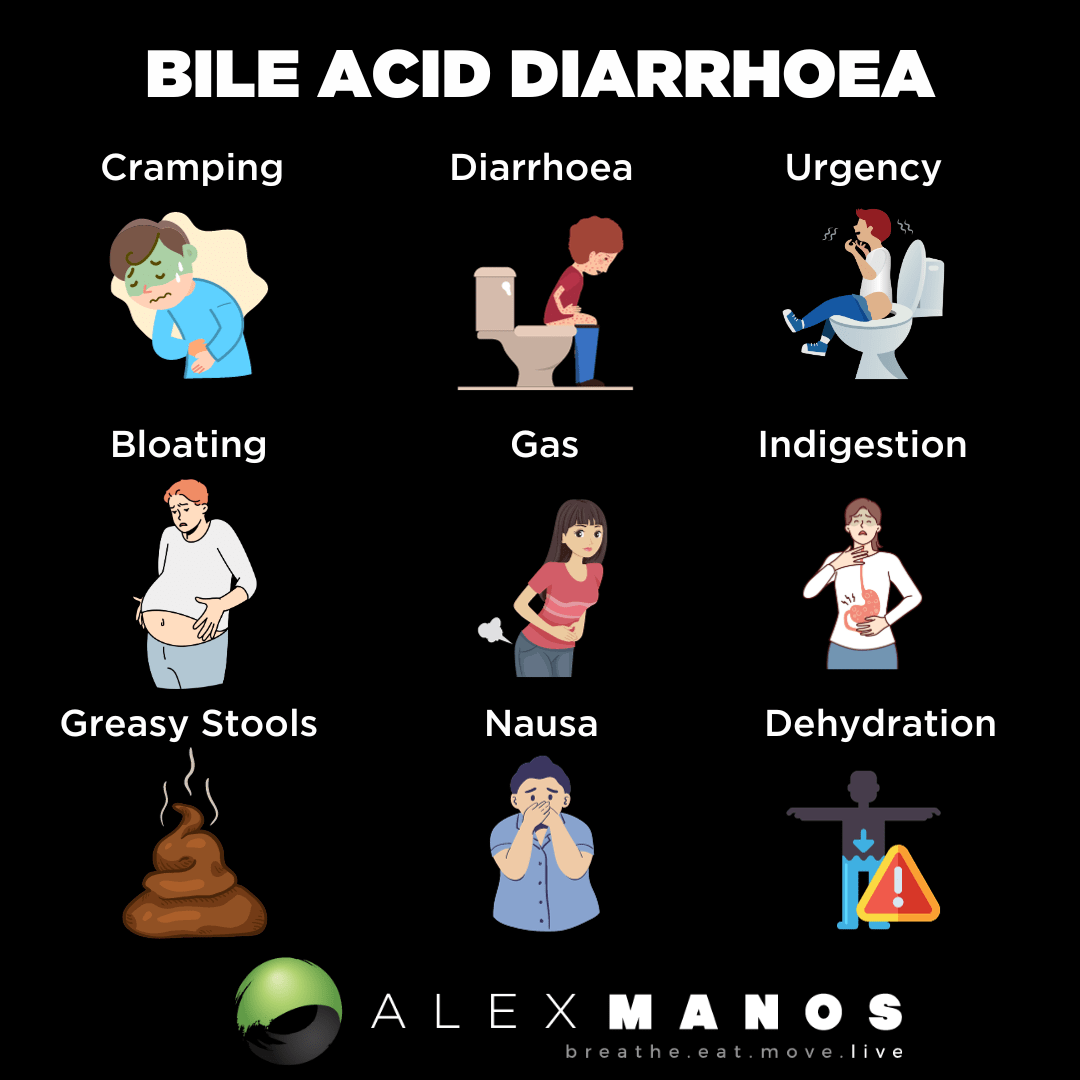Welcome to my blog ‘Bile Acid Diarrhoea: A Common Cause Of Diarrhoea’.
What Is Bile Acid Diarrhoea?
Bile acid diarrhea (BAD) is usually seen in patients with ileal Crohn’s disease or ileal resection. However, 25% to 50% of patients with functional diarrhoea or diarrhea-predominant irritable bowel syndrome (IBS-D) also have evidence of Bile acid diarrhea. It is estimated that 1% of the population may have Bile acid diarrhea (1).
The impact of the microbiome on IBS-D could occur via the actions of microbiome-derived metabolites, including bile acids. Bile acids are produced in the liver, which help break down fats into something called ‘micelles’ for digestion and absorption. Approximately 95% of secreted bile acids are reabsorbed in the small intestine, and the remaining bile acids reach the colon, where they are metabolised by gut bacteria, forming secondary BAs.
According to the characteristics of bile acid profiles, bile acids can exert their variable effects on gut function, including fluid secretion, mucosal permeability, and bowel motility. Bile acids can also modify gut microbiota.
Given the vital role of gut microbiome and bile acids in regulating gut function, their bidirectional relationship may contribute to the pathophysiology of IBS. Indeed, individuals with IBS have been reported to have altered microbial profiles and modified bile acids profiles.
What Causes Bile Acid Diarrhoea
The causes of Bile acid diarrhea include:
- A deficiency in fibroblast growth factor 19 (FGF-19), a hormone produced in enterocytes that regulates hepatic bile acid (BA) synthesis.
- Genetic variations that affect the proteins involved in bile acid enterohepatic circulation and synthesis or in the TGR5 receptor that mediates the actions of BA in colonic secretion and motility.
How Do Bile Acids Cause Diarrhoea?
BAs enhance mucosal permeability, induce water and electrolyte secretion, and accelerate colonic transit partly by stimulating propulsive high-amplitude colonic contractions. There is an increased proportion of primary BAs in the stool of patients with IBS-D, and some changes in the fecal microbiome have been described.
The Gut Microbiome & Bile Acids
Gut bacteria that convert primary BAs to secondary BAs belong to a limited number of species, mainly Clostridiales.
The gut microbiome participates in the bile acids metabolism to produce unconjugated and secondary bile acids for their possession of bile salt hydrolase (BSH) and bile acid–inducible enzymes (BAI). The gut dysbiosis and bile acid dysmetabolism that existed in patients with IBD have been discovered by many studies, the levels of secondary bile acids are lower, primary bile acids are elevated because of the impairment of microbiota deconjugation and transformation activities, and the microbial BSH activity is decreased. Therefore, gut microbiota and bile acids metabolism play important roles, which have been studied in IBD.
IBS, The Microbiome & Bile Aids
Like gut microbiota modify bile acid profile, bile acids can shape gut microbiota via direct and indirect actions. Bile acids have prosecretory effects and regulates gut motility. Bile acids can also affect gut sensitivity.
Individuals with IBS have been reported to have altered microbial profiles and modified bile acids profiles. A significant increase in fecal primary bile acid and a corresponding decrease in secondary bile acids have been observed in IBS with predominant diarrhoea. In addition, primary bile acids was positively correlated with IBS symptoms. In IBS with predominant diarrhea, bacteria with reduced abundance mainly belonged to the genera in Ruminococcaceae and exhibited a negative correlation with primary bile acids. Integrating the analysis of the gut microbiota and bile acids could better understanding of IBS pathophysiology
Bile Acids in Small Intestinal Bacterial Overgrowth
Small intestinal bacterial overgrowth (SIBO) is one manifestation of gut microbiome dysbiosis and is highly prevalent in IBS. Many bacteria in the small intestine have the capacity to metabolize BAs. Shindo et al isolated bacterial species from the jejunal fluid obtained from patients with progressive systemic sclerosis and positive CO2 breath test.
The isolated Bacteroides vulgatus, Eubacterium lentum, Enterococcus, and Lactobacillus bifidus (except for E. coli and Aerobacter aerogenes) were capable of hydrolyzing conjugated BAs in ox gall. Similarly, higher unconjugated BAs from the upper gut aspirate have been observed in malabsorption syndrome patients with SIBO than those without SIBO. However, the amount of unconjugated BAs did not correlated with colony counts of isolated bacteria.
This observation suggests the different BSH activity among the isolated bacteria. As unconjugated BAs are absorbed from the small intestine into the portal blood, elevated unconjugated serum BA levels have also been found in patients with SIBO
How Do You Diagnose Bile Acid Diarrhoea?
There are several methods of diagnosing bile acid diarrhea including:
- Selenium homotaurocholic acid test retention.
- Serum C4, or/and FGF-19.
- Fecal BA measurement.
- Presently, therapeutic trials with bile acid sequestrants, such as cholestyramine, are most commonly used for diagnosis.
How Do You Treat Bile Acid Diarrhoea?
Conventional treatment involves the use of bile acid sequestrants including cholestyramine, colestipol, and colesevelam. F
XR agonists such as obeticholic acid constitute a promising new approach to treating bile acid diarrhoea.
There is also evidence that probiotics can be helpful.
Probiotics And Bile Acid Diarrhoea
Probiotic VSL#3 consisted of 8 Gram-positive bacteria strains (1 species of Streptococcus thermophilus, 3 species of Bifidobacterium, and 4 species of Lactobacillus). Degirolamo et al. show the evidence that VSL#3 probiotics could be helpful in bile acid diarrhoea by helping to promote ileal BA deconjugation and fecal BA excretion and increase hepatic BA neosynthesis in vivo by downregulation of the gut-liver FXR-FGF15 axis. Moreover, probiotic VSL#3 makes a vital influence on decreasing visceral sensitivity in patients with IBS, resetting colonic expression level of subsets of genes regulating inflammation and pain and reducing visceral pain perception in the murine model of IBS.
Some other studies indicated the L. acidophilus NCFM and L. johnsonii strain 100–100 could be involved in the BA metabolism owing to the ability of hydrolyzing bile salts. (3)
BSH activity was much higher after oral take of Lactobacillus acidophilus or Bifidobacterium infantis than Streptococcus thermophilus. Recently, a dual probiotics system including Lactobacillus delbrueckii subsp. bulgaricus and LGG was fabricated, and LGG could increase the abundance of BSH-containing gut bacteria (4)
References
- Bile Acid diarrhea: prevalence, pathogenesis, and therapy
- Bile Acid and Gut Microbiota in Irritable Bowel Syndrome
- Gut Microbiota-Bile Acid Crosstalk in Diarrhea-Irritable Bowel Syndrome
- Regulation of gut microbiota-bile acids axis by probiotics in inflammatory bowel disease
Alex is a certified Functional Medicine Practitioner (IFMCP) and has a MSc in Personalised Nutrition. He is also a breathwork facilitator with a background in personal training and massage therapy. He also runs The Resiliency Program - a 24 week program aimed at building physical, mental, emotional, and spiritual resilience.





